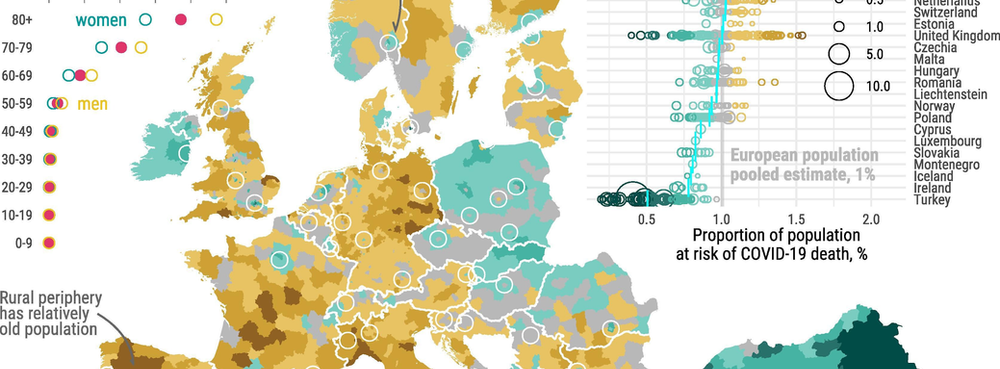Population age structures alone may account for four-fold variation in average regional COVID-19 infection-fatality ratios across Europe according to a ,new map and comment piece by ,Ilya Kashnitsky ,and ,José Manuel Aburto, published in World Development.
The COVID-19 pandemic is unequally claiming lives across age groups. Since death risks increase sharply with age for people infected by SARS-CoV-2 (Ferguson et al., 2020), the new coronavirus poses great challenges to populations with larger proportions of fragile people at older ages. Differences in population age compositions partly explain the spread and the crude fatality measures of the disease (Dowd et al., 2020). Looking at population age structures is therefore critically important to assess the potential impact of COVID-19 on mortality in Europe, the oldest part of the world with considerable variations in the degree of ageing (Kashnitsky and Schöley, 2018).
The map presented below summarises regional differences in population age structures between the NUTS-3 regions of Europe in the context of unequal age- and sex-specific death risks associated with the spread of the COVID-19 pandemic. The urban/rural dimension turns out to be very important as the remote rural areas are also the oldest. In the map NUTS-3 regions of Europe are coloured according to the deviation from European pooled estimate of the proportion of population at risk of death due to COVID-19. Kashnitsky and Aburto assume that 5/6 of the populations get infected and experience age-specific infection-fatality ratios (IFRs) modelled by the Imperial College COVID-19 Response Team. They adjust IFRs by sex ratios of age-specific case-fatality ratios observed in the European countries that are included in the COVerAGE-DB. Thus, effectively introduce a summary measure of population age structures focused on the most vulnerable to the pandemic. Such an estimate for the total European population is 1%. The map reflects the unequal population age structures rather than the precise figures on COVID-19 fatality. It is a case-if scenario that highlights the possible effect of the population age structures, a demographic perspective. This analysis clearly shows the contribution of regional differences in population age structures to the magnitude of the pandemic – other things equal, Kashnitsky and Aburto expect to see a four-fold variation in average regional infection-fatality ratios across Europe due only to differences in the population structures.

This approach requires careful consideration of the assumptions and limitations and the lack of high-quality data on the unfolding pandemic (read the full article for further details). Despite the limitations, the regional differences in age structures shown here are relevant for the story of the unfolding pandemic and can inform potential scenarios in Europe, as long as the relative differences in fatality between age groups stay proportional. The map highlights that if the spread of the disease is not mitigated, the most affected regions are likely to be the remote periphery with relatively old populations, which in some countries are also less likely to have enough access to healthcare (Verhagen et al., 2020).



